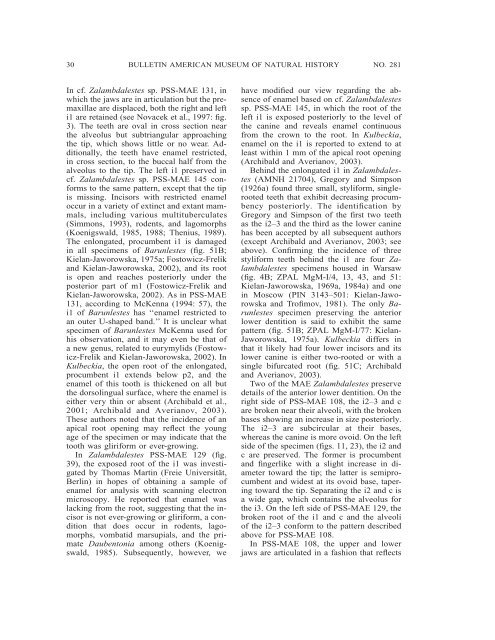zalambdalestes - American Museum of Natural History
zalambdalestes - American Museum of Natural History
zalambdalestes - American Museum of Natural History
Create successful ePaper yourself
Turn your PDF publications into a flip-book with our unique Google optimized e-Paper software.
30 BULLETIN AMERICAN MUSEUM OF NATURAL HISTORY NO. 281<br />
In cf. Zalambdalestes sp. PSS-MAE 131, in<br />
which the jaws are in articulation but the premaxillae<br />
are displaced, both the right and left<br />
i1 are retained (see Novacek et al., 1997: fig.<br />
3). The teeth are oval in cross section near<br />
the alveolus but subtriangular approaching<br />
the tip, which shows little or no wear. Additionally,<br />
the teeth have enamel restricted,<br />
in cross section, to the buccal half from the<br />
alveolus to the tip. The left i1 preserved in<br />
cf. Zalambdalestes sp. PSS-MAE 145 conforms<br />
to the same pattern, except that the tip<br />
is missing. Incisors with restricted enamel<br />
occur in a variety <strong>of</strong> extinct and extant mammals,<br />
including various multituberculates<br />
(Simmons, 1993), rodents, and lagomorphs<br />
(Koenigswald, 1985, 1988; Thenius, 1989).<br />
The enlongated, procumbent i1 is damaged<br />
in all specimens <strong>of</strong> Barunlestes (fig. 51B;<br />
Kielan-Jaworowska, 1975a; Fostowicz-Frelik<br />
and Kielan-Jaworowska, 2002), and its root<br />
is open and reaches posteriorly under the<br />
posterior part <strong>of</strong> m1 (Fostowicz-Frelik and<br />
Kielan-Jaworowska, 2002). As in PSS-MAE<br />
131, according to McKenna (1994: 57), the<br />
i1 <strong>of</strong> Barunlestes has ‘‘enamel restricted to<br />
an outer U-shaped band.’’ It is unclear what<br />
specimen <strong>of</strong> Barunlestes McKenna used for<br />
his observation, and it may even be that <strong>of</strong><br />
a new genus, related to eurymylids (Fostowicz-Frelik<br />
and Kielan-Jaworowska, 2002). In<br />
Kulbeckia, the open root <strong>of</strong> the enlongated,<br />
procumbent i1 extends below p2, and the<br />
enamel <strong>of</strong> this tooth is thickened on all but<br />
the dorsolingual surface, where the enamel is<br />
either very thin or absent (Archibald et al.,<br />
2001; Archibald and Averianov, 2003).<br />
These authors noted that the incidence <strong>of</strong> an<br />
apical root opening may reflect the young<br />
age <strong>of</strong> the specimen or may indicate that the<br />
tooth was gliriform or ever-growing.<br />
In Zalambdalestes PSS-MAE 129 (fig.<br />
39), the exposed root <strong>of</strong> the i1 was investigated<br />
by Thomas Martin (Freie Universität,<br />
Berlin) in hopes <strong>of</strong> obtaining a sample <strong>of</strong><br />
enamel for analysis with scanning electron<br />
microscopy. He reported that enamel was<br />
lacking from the root, suggesting that the incisor<br />
is not ever-growing or gliriform, a condition<br />
that does occur in rodents, lagomorphs,<br />
vombatid marsupials, and the primate<br />
Daubentonia among others (Koenigswald,<br />
1985). Subsequently, however, we<br />
have modified our view regarding the absence<br />
<strong>of</strong> enamel based on cf. Zalambdalestes<br />
sp. PSS-MAE 145, in which the root <strong>of</strong> the<br />
left i1 is exposed posteriorly to the level <strong>of</strong><br />
the canine and reveals enamel continuous<br />
from the crown to the root. In Kulbeckia,<br />
enamel on the i1 is reported to extend to at<br />
least within 1 mm <strong>of</strong> the apical root opening<br />
(Archibald and Averianov, 2003).<br />
Behind the enlongated i1 in Zalambdalestes<br />
(AMNH 21704), Gregory and Simpson<br />
(1926a) found three small, styliform, singlerooted<br />
teeth that exhibit decreasing procumbency<br />
posteriorly. The identification by<br />
Gregory and Simpson <strong>of</strong> the first two teeth<br />
as the i2–3 and the third as the lower canine<br />
has been accepted by all subsequent authors<br />
(except Archibald and Averianov, 2003; see<br />
above). Confirming the incidence <strong>of</strong> three<br />
styliform teeth behind the i1 are four Zalambdalestes<br />
specimens housed in Warsaw<br />
(fig. 4B; ZPAL MgM-I/4, 13, 43, and 51:<br />
Kielan-Jaworowska, 1969a, 1984a) and one<br />
in Moscow (PIN 3143–501: Kielan-Jaworowska<br />
and Tr<strong>of</strong>imov, 1981). The only Barunlestes<br />
specimen preserving the anterior<br />
lower dentition is said to exhibit the same<br />
pattern (fig. 51B; ZPAL MgM-I/77: Kielan-<br />
Jaworowska, 1975a). Kulbeckia differs in<br />
that it likely had four lower incisors and its<br />
lower canine is either two-rooted or with a<br />
single bifurcated root (fig. 51C; Archibald<br />
and Averianov, 2003).<br />
Two <strong>of</strong> the MAE Zalambdalestes preserve<br />
details <strong>of</strong> the anterior lower dentition. On the<br />
right side <strong>of</strong> PSS-MAE 108, the i2–3 and c<br />
are broken near their alveoli, with the broken<br />
bases showing an increase in size posteriorly.<br />
The i2–3 are subcircular at their bases,<br />
whereas the canine is more ovoid. On the left<br />
side <strong>of</strong> the specimen (figs. 11, 23), the i2 and<br />
c are preserved. The former is procumbent<br />
and fingerlike with a slight increase in diameter<br />
toward the tip; the latter is semiprocumbent<br />
and widest at its ovoid base, tapering<br />
toward the tip. Separating the i2 and c is<br />
a wide gap, which contains the alveolus for<br />
the i3. On the left side <strong>of</strong> PSS-MAE 129, the<br />
broken root <strong>of</strong> the i1 and c and the alveoli<br />
<strong>of</strong> the i2–3 conform to the pattern described<br />
above for PSS-MAE 108.<br />
In PSS-MAE 108, the upper and lower<br />
jaws are articulated in a fashion that reflects
















